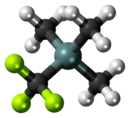Trifluoromethyltrimethylsilane
| |||
| Names | |||
|---|---|---|---|
| Preferred IUPAC name
Trimethyl(trifluoromethyl)silane | |||
| Other names
Ruppert's reagent; TFMTMS; CF3SiMe3
| |||
| Identifiers | |||
3D model (JSmol)
|
|||
| ChemSpider | |||
| ECHA InfoCard | 100.106.346 | ||
PubChem CID
|
|||
| UNII | |||
CompTox Dashboard (EPA)
|
|||
| |||
| |||
| Properties | |||
| C4H9F3Si | |||
| Molar mass | 142.196 g·mol−1 | ||
| Appearance | Colorless liquid | ||
| Density | 0.9626 g/cm3 at 20 °C | ||
| Boiling point | 54 to 55 °C (129 to 131 °F; 327 to 328 K) | ||
Except where otherwise noted, data are given for materials in their standard state (at 25 °C [77 °F], 100 kPa).
| |||
Trifluoromethyltrimethylsilane (known as Ruppert-Prakash reagent, TMSCF3) is an organosilicon compound with the formula CF3Si(CH3)3. It is a colorless liquid. The compound is a reagent used in organic chemistry for the introduction of the trifluoromethyl group. The compound was first prepared in 1984 by Ingo Ruppert[1] and further developed as a reagent by G. K. Surya Prakash.[2][3]
Preparation
[edit]The reagent is prepared from trimethylsilyl chloride and bromotrifluoromethane in the presence of a phosphorus(III) reagent that serves as a halogen acceptor.[4]
Use in organic synthesis
[edit]In the presence of a metal salt (M+ X−), the reagent reacts with aldehydes and ketones to give a trimethylsilyl ether, the net product of insertion of the carbonyl into the Si-CF3 bond. Hydrolysis gives trifluoromethyl methanols. The reagent also converts esters to trifluoromethyl ketones. A typical initiator is a soluble fluoride-containing species such as tetrabutylammonium fluoride; however, simple alkoxides such as KOtBu are also effective.[5] The mechanism begins by generation of Si(CH3)3X and a highly reactive [CF3]− (trifluoromethide) intermediate. The [CF3]− attacks the carbonyl to generate an alkoxide anion. The alkoxide is silylated by the reagent to give the overall addition product, plus [CF3]−, thus propagating an anionic chain reaction. The reagent competes with the carbonyl for the reactive intermediate, rapidly sequestering [CF3]− in a reversibly-generated -ate complex [(CF3)2Si(CH3)3]−. This -ate complex is unable to react directly with the carbonyl, resulting in powerful inhibition of the chain reaction by the reagent. This inhibitory process is common to all anion-initiated reactions of the reagent, with the identity of the counter-cation (M+) playing a major role in controlling the overall rate.[6]
The reagent has largely supplanted trifluoromethyllithium, which is not isolable and rapidly decomposes to yield lithium fluoride and difluorocarbene.
References
[edit]- ^ Ruppert, Ingo; Schlich, Klaus; Volbach, Wolfgang (1984). "Fluorinated organometallic compounds. 18. First trifluoromethyl-substituted organyl(chloro)silanes". Tetrahedron Letters. 25 (21): 2195–2198. doi:10.1016/S0040-4039(01)80208-2.
- ^ Prakash, G. K. Surya; Yudin, Andrei K. (1997-05-01). "Perfluoroalkylation with Organosilicon Reagents". Chemical Reviews. 97 (3): 757–786. doi:10.1021/cr9408991. ISSN 0009-2665. PMID 11848888.
- ^ Liu, Xiao; Xu, Cong; Wang, Mang; Liu, Qun (2015-01-28). "Trifluoromethyltrimethylsilane: Nucleophilic Trifluoromethylation and Beyond". Chemical Reviews. 115 (2): 683–730. doi:10.1021/cr400473a. ISSN 0009-2665. PMID 24754488.
- ^ Pichika Ramaiah; Ramesh Krishnamurti; G. K. Surya Prakash (1995). "1-Trifluoromethyl-1-cyclohexanol". Org. Synth. 72: 232. doi:10.15227/orgsyn.072.0232.
- ^ George. A. Olah; G. K. Surya Prakash; Qi Wang; Xing-Ya Li; María Sánchez-Roselló; Carlos del Pozo Losada; José Luis Aceña (2009). Trifluoromethyltrimethylsilane. doi:10.1002/047084289X.rt253.pub2. ISBN 978-0471936237.
((cite book)):|journal=ignored (help) - ^ Craig P. Johnston; Thomas H. West; Ruth E. Dooley; Marc Reid; Ariana B. Jones; Edward J. King; Andrew G. Leach; Guy C. Lloyd-Jones (2018). "Anion-Initiated Trifluoromethylation by TMSCF3: Deconvolution of the Siliconate–Carbanion Dichotomy by Stopped-Flow NMR/IR". Journal of the American Chemical Society. 140 (35): 11112–11124. doi:10.1021/jacs.8b06777. hdl:10023/16552. PMC 6133236. PMID 30080973.
Text is available under the CC BY-SA 4.0 license; additional terms may apply.
Images, videos and audio are available under their respective licenses.


